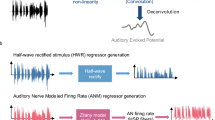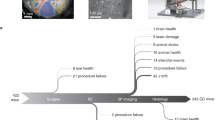Abstract
Studies of auditory cortex are often driven by the assumption, derived from our better understanding of visual cortex, that basic physical properties of sounds are represented there before being used by higher-level areas for determining sound-source identity and location. However, we only have a limited appreciation of what the cortex adds to the extensive subcortical processing of auditory information, which can account for many perceptual abilities. This is partly because of the approaches that have dominated the study of auditory cortical processing to date, and future progress will unquestionably profit from the adoption of methods that have provided valuable insights into the neural basis of visual perception. At the same time, we propose that there are unique operating principles employed by the auditory cortex that relate largely to the simultaneous and sequential processing of previously derived features and that therefore need to be studied and understood in their own right.
This is a preview of subscription content, access via your institution
Access options
Subscribe to this journal
Receive 12 print issues and online access
$209.00 per year
only $17.42 per issue
Buy this article
- Purchase on Springer Link
- Instant access to full article PDF
Prices may be subject to local taxes which are calculated during checkout
Similar content being viewed by others
References
Brown, C.H. & May, B.J. Comparative mammalian sound localization. in Sound Source Localization, Springer Handbook of Auditory Research (eds. Popper, A.N. & Fay, R.R.) 124–178 (Springer, New York, 2005).
DeValois, R.L. & DeValois, K.K. Spatial Vision. Oxford Psychology Series 14 (Oxford University Press, Oxford, UK, 1990).
Tyler, C.W. & Hamer, R.D. Analysis of visual modulation sensitivity. IV. Validity of the Ferry-Porter law. J. Opt. Soc. Am. A 7, 743–758 (1990).
Viemeister, N.F. & Plack, C.J. Time analysis. in Human Psychophysics, Springer Handbook of Auditory Research (eds. Yost, W.A., Popper, A.N. & Fay, R.R.) 116–154 (Springer, New York, 1993).
Hirsch, J.A. & Martinez, L.M. Circuits that build visual cortical receptive fields. Trends Neurosci. 29, 30–39 (2006).
Palmer, A.R. Anatomy and physiology of the auditory brainstem. in Auditory Evoked Potentials (eds. Burkard, R.F., Don, M. & Eggermont, J.J.) 200–228 (Lippincott Williams and Wilkins, Baltimore, 2007).
Nelken, I., Fishbach, A., Las, L., Ulanovsky, N. & Farkas, D. Primary auditory cortex of cats: feature detection or something else? Biol. Cybern. 89, 397–406 (2003).
Read, H.L., Winer, J.A. & Schreiner, C.E. Modular organization of intrinsic connections associated with spectral tuning in cat auditory cortex. Proc. Natl. Acad. Sci. USA 98, 8042–8047 (2001).
Clarey, J.C., Barone, P. & Imig, T.J. Physiology of thalamus and cortex. in The Mammalian Auditory Pathway: Neurophysiology. Springer Handbook of Auditory Research (eds. Popper, A.N. & Fay, R.R.) 232–335 (Springer, New York, 1992).
Wang, X., Lu, T., Snider, R.K. & Liang, L. Sustained firing in auditory cortex evoked by preferred stimuli. Nature 435, 341–346 (2005).
Hromádka, T., Deweese, M.R. & Zador, A.M. Sparse representation of sounds in the unanesthetized auditory cortex. PLoS Biol. 6, e16 (2008).
deCharms, R.C., Blake, D.T. & Merzenich, M.M. Optimizing sound features for cortical neurons. Science 280, 1439–1443 (1998).
Schnupp, J.W.H., Mrsic-Flogel, T.D. & King, A.J. Linear processing of spatial cues in primary auditory cortex. Nature 414, 200–204 (2001).
Fritz, J.B., Elhilali, M. & Shamma, S.A. Differential dynamic plasticity of A1 receptive fields during multiple spectral tasks. J. Neurosci. 25, 7623–7635 (2005).
Bar-Yosef, O. & Nelken, I. The effects of background noise on the neural responses to natural sounds in cat primary auditory cortex. Front. Comput. Neurosci. 1, 1–14 (2007).
Machens, C.K., Wehr, M.S. & Zador, A.M. Linearity of cortical receptive fields measured with natural sounds. J. Neurosci. 24, 1089–1100 (2004).
Serre, T., Oliva, A. & Poggio, T. A feedforward architecture accounts for rapid categorization. Proc. Natl. Acad. Sci. USA 104, 6424–6429 (2007).
Kiani, R., Esteky, H., Mirpour, K. & Tanaka, K. Object category structure in response patterns of neuronal population in monkey inferior temporal cortex. J. Neurophysiol. 97, 4296–4309 (2007).
Martinez, L.M. et al. Receptive field structure varies with layer in the primary visual cortex. Nat. Neurosci. 8, 372–379 (2005).
Ohki, K. et al. Highly ordered arrangement of single neurons in orientation pinwheels. Nature 442, 925–928 (2006).
Schreiner, C.E. & Winer, J.A. Auditory cortex mapmaking: principles, projections and plasticity. Neuron 56, 356–365 (2007).
Linden, J.F. & Schreiner, C.E. Columnar transformations in auditory cortex? A comparison to visual and somatosensory cortices. Cereb. Cortex 13, 83–89 (2003).
Tanaka, K. Inferotemporal cortex and object vision. Annu. Rev. Neurosci. 19, 109–139 (1996).
Wollberg, Z. & Newman, J.D. Auditory cortex of squirrel monkey: response patterns of single cells to species-specific vocalizations. Science 175, 212–214 (1972).
Chechik, G. et al. Reduction of information redundancy in the ascending auditory pathway. Neuron 51, 359–368 (2006).
Suga, N. Principles of auditory information-processing derived from neuroethology. J. Exp. Biol. 146, 277–286 (1989).
Joris, P.X., Schreiner, C.E. & Rees, A. Neural processing of amplitude-modulated sounds. Physiol. Rev. 84, 541–577 (2004).
Chi, T., Ru, P. & Shamma, S.A. Multiresolution spectrotemporal analysis of complex sounds. J. Acoust. Soc. Am. 118, 887–906 (2005).
Ulanovsky, N., Las, L. & Nelken, I. Processing of low-probability sounds by cortical neurons. Nat. Neurosci. 6, 391–398 (2003).
Weinberger, N.M. Specific long-term memory traces in primary auditory cortex. Nat. Rev. Neurosci. 5, 279–290 (2004).
King, A.J. et al. Physiological and behavioral studies of spatial coding in the auditory cortex. Hear. Res. 229, 106–115 (2007).
Polley, D.B., Steinberg, E.E. & Merzenich, M.M. Perceptual learning directs auditory cortical map reorganization through top-down influences. J. Neurosci. 26, 4970–4982 (2006).
Schnupp, J.W.H., Hall, T.M., Kokelaar, R.F. & Ahmed, B. Plasticity of temporal pattern codes for vocalization stimuli in primary auditory cortex. J. Neurosci. 26, 4785–4795 (2006).
Kobatake, E., Wang, G. & Tanaka, K. Effects of shape-discrimination training on the selectivity of inferotemporal cells in adult monkeys. J. Neurophysiol. 80, 324–330 (1998).
Yang, T. & Maunsell, J.H. The effect of perceptual learning on neuronal responses in monkey visual area V4. J. Neurosci. 24, 1617–1626 (2004).
Suga, N. Role of corticofugal feedback in hearing. J. Comp. Physiol. A Neuroethol. Sens. Neural. Behav. Physiol. 194, 169–183 (2008).
Ungerleider, L.G. & Haxby, J.V. 'What' and 'where' in the human brain. Curr. Opin. Neurobiol. 4, 157–165 (1994).
Alain, C., Arnott, S.R., Hevenor, S., Graham, S. & Grady, C.L. 'What' and 'where' in the human auditory system. Proc. Natl. Acad. Sci. USA 98, 12301–12306 (2001).
Tian, B., Reser, D., Durham, A., Kustov, A. & Rauschecker, J.P. Functional specialization in rhesus monkey auditory cortex. Science 292, 290–293 (2001).
Kaas, J.H. & Hackett, T.A. 'What' and 'where' processing in auditory cortex. Nat. Neurosci. 2, 1045–1047 (1999).
Lomber, S.G. & Malhotra, S. Double dissociation of 'what' and 'where' processing in auditory cortex. Nat. Neurosci. 11, 609–616 (2008).
Ghazanfar, A.A. & Schroeder, C.E. Is neocortex essentially multisensory? Trends Cogn. Sci. 10, 278–285 (2006).
Harrington, I.A., Stecker, G.C., Macpherson, E.A. & Middlebrooks, J.C. Spatial sensitivity of neurons in the anterior, posterior, and primary fields of cat auditory cortex. Hear. Res. 240, 22–41 (2008).
Recanzone, G.H. Representation of con-specific vocalizations in the core and belt areas of the auditory cortex in the alert macaque monkey. J. Neurosci. 28, 13184–13193 (2008).
Bizley, J.K., Walker, K.M.M., Silverman, B.W., King, A.J. & Schnupp, J.W.H. Interdependent encoding of pitch, timbre and spatial location in auditory cortex. J. Neurosci. 29, 2064–2075 (2009).
Salzman, C.D., Britten, K.H. & Newsome, W.T. Cortical microstimulation influences perceptual judgments of motion direction. Nature 346, 174–177 (1990).
Otto, K.J., Rousche, P.J. & Kipke, D.R. Microstimulation in auditory cortex provides a substrate for detailed behaviors. Hear. Res. 210, 112–117 (2005).
Yang, Y., DeWeese, M.R., Otazu, G.H. & Zador, A.M. Millisecond-scale differences in neural activity in auditory cortex can drive decisions. Nat. Neurosci. 11, 1262–1263 (2008).
Huber, D. et al. Sparse optical microstimulation in barrel cortex drives learned behavior in freely moving mice. Nature 451, 61–64 (2008).
Hubel, D.H., Henson, C.O., Rupert, A. & Galambos, R. Attention units in the auditory cortex. Science 129, 1279–1280 (1959).
Acknowledgements
We are grateful to B. Willmore for discussions. Financial support was provided by the Wellcome Trust (a Principal Research Fellowship to A.J.K.) and by the Israeli Science Foundation (I.N.).
Author information
Authors and Affiliations
Corresponding authors
Rights and permissions
About this article
Cite this article
King, A., Nelken, I. Unraveling the principles of auditory cortical processing: can we learn from the visual system?. Nat Neurosci 12, 698–701 (2009). https://doi.org/10.1038/nn.2308
Published:
Issue Date:
DOI: https://doi.org/10.1038/nn.2308
This article is cited by
-
Auditory cortex modelled as a dynamical network of oscillators: understanding event-related fields and their adaptation
Biological Cybernetics (2022)
-
Prosodic influence in face emotion perception: evidence from functional near-infrared spectroscopy
Scientific Reports (2020)
-
Feature-dependent intrinsic functional connectivity across cortical depths in the human auditory cortex
Scientific Reports (2018)
-
Neurons along the auditory pathway exhibit a hierarchical organization of prediction error
Nature Communications (2017)
-
Stimulus-specific adaptation in the inferior colliculus of the mouse: anesthesia and spontaneous activity effects
Brain Structure and Function (2015)



